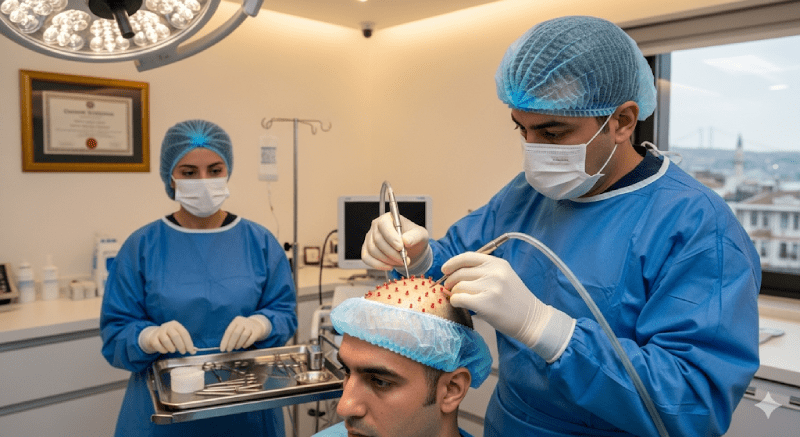Introduction: Patience and Realistic Expectations
Hair transplantation offers a permanent and effective solution for individuals experiencing hair loss. However, the success of this operation does not solely depend on the surgeon’s skill or the technique used. Another factor just as important as the operation is the process of hair growth and development. This process is a dynamic, gradual cycle that requires patience. One of the most common questions from individuals considering or having undergone a hair transplant is, “When will I see results?” In this comprehensive guide, we will detail the month-by-month progression of results, the key factors affecting this process, and the points to be aware of. It’s important to remember that every individual’s body responds differently, and results can vary from person to person. Approaching this process with realistic expectations is the key to satisfaction.
The First 24 Hours: Post-Operative Care
The first 24 hours immediately following a hair transplant operation are the critical start of the recovery process. During this period, it is completely normal to experience slight pain, swelling, and redness in both the donor area (where the hair follicles were harvested) and the recipient area. The grafts are visible as small, red dots in the transplanted area. The most crucial aspect at this stage is to avoid any contact that could jeopardize the operation’s success. It is vital to not touch the transplanted area, to sleep with your head elevated, and to regularly use the medications prescribed by the surgeon. The first wash is usually performed at the clinic 24-48 hours after the operation using a special lotion and shampoo. This initial wash must be done very gently to prevent the grafts from dislodging.
The First Week: Beginning of the Recovery Process
The first week after the operation is when the healing in the transplanted and donor areas accelerates. The redness and scabbing in the recipient area become more pronounced. These scabs form around the grafts and in the micro-incisions made during the operation. They generally begin to fall off on their own within 7-10 days. An itching sensation is normal during this time, but you must avoid scratching. The donor area heals more quickly; the redness and swelling there gradually subside. By the end of this week, the process of the transplanted hair follicles settling into their new locations is largely complete. Continuing gentle washes and following the surgeon’s instructions are essential for a successful recovery.
The Period of Shock Loss
Towards the end of the first month or the beginning of the second, a process called shock loss begins. This is a temporary phase where a large portion or all of the transplanted hair sheds. Shock loss is a completely natural and expected part of the hair transplant process. Due to stress, trauma, and changes in blood flow, the hair follicles enter a resting phase (telogen), shedding the old hair shafts to make way for new, stronger hairs to grow. This situation can cause concern for many patients, but it is important to know that this phase is temporary and the hair follicles are still alive and healthy.
The Waiting and Despair Phase
The second month, when shock loss peaks, can be one of the most psychologically challenging periods for patients. The shedding of the transplanted hair and the absence of new hair growth can create a feeling of “waiting” and even “despair.” At this stage, the hair’s appearance may not be much different from before the operation. To get through this period, it’s necessary to be patient and trust in the natural progression of the process. During this time, the hair follicles continue to gather strength to produce new hairs.
The First Wispy Hairs
One of the most exciting moments after a hair transplant begins around the third month. The first wispy and thin hair strands start to appear in the transplanted area. These hairs may initially look very weak and lifeless, but this is entirely normal. This stage is a sign that the follicles have successfully settled and that hair production has begun. These initial hair strands will thicken over time and develop into a stronger structure. Hair growth can be uneven, and it may grow faster in some areas than others.
Accelerated Hair Growth
The fourth month is when hair growth visibly accelerates. The first wispy hairs begin to thicken, and more new hair strands emerge. The appearance of the transplanted area slowly starts to change. By the end of this month, a noticeable fullness is felt in the bald areas, and the patient’s reflection in the mirror becomes increasingly satisfying. The hair that emerges at this stage is now stronger and gradually begins to resemble natural hair.
Halfway Through the Transformation
The sixth month is a turning point, reaching halfway through the hair transplant results. By the end of this month, approximately 50-60% of the transplanted hair has typically grown and reached a noticeable density. The hair’s thickness and texture continue to improve. At this stage, patients can style their hair and begin to enjoy their new look. The donor area has fully healed and returned to its normal appearance.
Increased Fullness and Density
The eighth month is when hair transplant results mature further and become fuller. The hair now has a thicker, denser, and more voluminous appearance. A large part of the transplanted area is covered with new hair. At this stage, the final shape of the hairline and overall hair appearance begin to become apparent. Patients’ self-confidence increases, which has a positive impact on their social lives.
Results Become Apparent
The tenth month is the period when the hair transplant results are largely complete and at their most apparent. 80-90% of the transplanted hair has grown. The hair has a natural and healthy appearance, and it is not externally obvious that a transplant has been performed. The hairline, direction, and density have reached their final shape. During this period, the areas that were bald before the transplant are now covered with natural hair.
Approaching the Final Results
By the end of the first year, nearly all of the hair transplant results have been achieved. The vast majority of the transplanted hair has grown healthily and reached its final thickness. At this point, patients are generally highly satisfied with the results. The final state of the hair is very close to the look that will remain for life.
The Completed Look
Hair transplant results fully settle 12 to 18 months after the operation. Hair in areas with slower blood flow, such as the crown, may take a little longer to reach its full thickness and density. By the 18th month, the final and permanent result of the hair transplant procedure has been achieved.

The Donor Area’s Healing Process
The donor area (usually the back of the neck) is just as important as the transplanted area after a hair transplant. Although redness and scabbing may be seen in the first few days, the donor area typically heals quickly within 1-2 weeks. The hair in this area grows back within 1-3 months after the transplant, and the traces of the operation are completely gone. In the FUE technique, the scars are micro-sized and not visible from the outside.
Why Does Shock Loss Occur?
Shock loss occurs due to physiological stress experienced by the transplanted hair follicles. During the operation, the separation of the grafts from their roots, their placement in a new environment, and the temporary changes in blood flow cause the follicles to enter the resting phase (telogen). This phase stops hair growth and sheds the hair shaft. This is a defense mechanism that helps the follicle conserve its energy for settling and preparing for a new growth cycle. This does not mean the transplant has failed; on the contrary, it is a natural process.
Which Factors Affect the Process?
How soon and how apparent the hair transplant results become depends on many factors:
- Age: Hair growth may be faster in younger patients.
- Genetics: Hair growth rate and hair strand thickness are influenced by genetic predisposition.
- Lifestyle: Smoking, alcohol consumption, and poor nutrition can negatively affect the process.
- Number of Grafts Transplanted: As the number of grafts increases, the healing and growth process can change accordingly.
- Hair Type: Wavy or curly hair can give a fuller appearance than straight hair.
- Health Status: Chronic illnesses or vitamin deficiencies can slow down the process.
- Post-Operative Care: The regular use of medications, proper washing, and sun protection directly impact the results.
Age-Related Differences
The recovery and hair growth rate after a hair transplant can vary depending on the patient’s age. Typically, individuals between the ages of 25 and 45 have higher hair growth cycles and healing rates. For patients 50 and older, the process may progress a bit more slowly, but this does not affect the quality of the final result.
The Role of Genetic Heritage
Just as hair loss has a genetic predisposition, your hair growth rate and the overall structure of your hair are also determined by your genes. This means some patients may complete the process more quickly, while others need to be more patient. The hair structure and growth rate of your family members can provide clues about your own process.
Nutrition and Hair Health
A healthy diet is a fundamental element for post-transplant recovery and hair growth. Consuming foods rich in protein, B vitamins (especially B7 – Biotin), iron, zinc, and vitamin C helps nourish and strengthen the hair follicles. A healthy diet plan supports faster and higher-quality hair growth.
Lifestyle Habits
Lifestyle changes after a hair transplant can significantly affect the success of the process. Getting enough regular sleep, avoiding stress, and increasing physical activity improve overall health and accelerate blood circulation. This ensures more oxygen and nutrients reach the transplanted grafts, supporting hair growth.
The Effect of Smoking and Alcohol
Smoking and alcohol are among the most important factors that negatively impact the post-transplant recovery process. Smoking constricts blood vessels, reducing blood flow and the amount of oxygen reaching the transplanted grafts. Alcohol can cause dehydration and weaken the body’s ability to heal. Staying away from these substances is essential for a quick and successful recovery.
The Importance of Medications and Supplements
After a hair transplant operation, regularly using the medications and vitamin supplements recommended by your surgeon supports the recovery process and encourages hair growth. Specifically, supplements like Biotin, Saw Palmetto, and zinc can help strengthen the hair follicles. However, it is important not to use any supplements without consulting your doctor.
Differences Between Hair Transplant Techniques
There may be small differences in the healing and hair growth rate between hair transplant techniques (FUE, DHI, etc.). For example, with the DHI technique, the recovery process may be slightly faster due to less trauma after the operation. However, there is no significant difference in terms of the final results.
The Possibility of a Second Session
In some cases, especially for extensive balding or when the desired density is not achieved, a second session may be necessary. The decision for a second session is usually made after the final results of the first operation are seen, which is 12-18 months later.
Signs of a Failed Transplant
Although rare, a hair transplant operation may not yield the desired results. Signs of a failed transplant include a lack of significant hair growth even after 12 months, complete shedding of the transplanted hair, or the hair growing in an unnatural direction. In such cases, it is important to consult a specialist.
Maintaining and Caring for the Results
The results obtained from a hair transplant are permanent with proper care. Post-transplant care is vital for maintaining hair health. It is necessary to use hair-loss-preventing shampoos and lotions, continue to eat a healthy diet, and avoid procedures that can damage hair (harsh chemicals, excessive heat, etc.).
Conclusion: The Value of the Journey
Hair transplantation is not just a surgical procedure but also a journey of patience and trust. Every stage, from the challenges of the first month to the ray of hope in the third month and the final result achieved at the end of a year, is part of this process. By approaching this journey with realistic expectations and following your doctor’s advice, it is highly likely that you will achieve a result that makes you happy when you look in the mirror. Remember, the best results are often seen in the most patient individuals.


